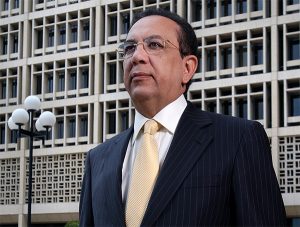Central Bank of the Dominican Republic: Dominican Economy Surges Ahead, Bringing Growth to Multiple Sectors

Governor: Héctor Valdez Albizu
In recent years, the Dominican economy has shown high growth rates in an environment of low inflationary pressures, which has allowed the strengthening of its macro-economic fundamentals.
Growth in economic activity has averaged 6.5% over the past five years — the highest in Latin America (LA), while inflation averaged just 2.2% over the same period.
The Dominican GDP expanded by seven% during 2018, driven by consumption and private investment, while year-on-year inflation stood at 1.17% at the end of the year. Good growth performance was accompanied by the reduction of “twin deficits” (the fiscal and current-account deficits in the Balance of Payments), reinforcing resilience to internal and external shocks. At the end of 2018, the non-financial public sector deficit reached -2.4% of GDP, while the current account deficit stood at minus 1.4% of GDP, below its historical average.
The good performance of the external sector has allowed the continued accumulation of international reserves, which closed for 2018 at all-time highs of $7.6bn, equivalent to a coverage of 4.4 months of imports. In addition, maintaining the relative stability of the exchange rate, together with low levels of inflation, has contributed to improving the competitiveness of the export sector in recent years.
The macroeconomic stability of the Dominican Republic, and the implementation of co-ordinated economic policies, have contributed to the perception of country risk (as measured through JP Morgan’s Emerging Market Bonds Index) of below the Latin American average since 2017. This is a reflection of international investor confidence in the fundamentals of the Dominican economy.
Another economic strength is a liquid, profitable and highly capitalised financial system. In this sense, the total assets of the system expanded by eight% during 2018, while the solvency index was more than 17%. It presented a return on equity (ROE) of 19.1% and average assets (ROA) of 2.3%, while the delinquency of the credit portfolio was just 1.6%.
In terms of this year’s performance, economic activity expanded by 5.1% during the January-May period, associated with a moderation of private investment and framed by the weakening of the global economy that has been affected by uncertainty factors, such as trade disputes between major countries and geopolitical tensions in some emerging economies. On the other hand, inflationary pressures have been reduced during 2019, with year-on-year inflation at 0.92% in June, significantly below the lower limit of the target range of the Central Bank of the Dominican Republic (CBDR) of 4.0% to 1.0%.
In this context of moderation of economic activity and low inflation levels, the BCDR reduced its Monetary Policy Rate by 50 basis points in June, from 5.50% to an even five% annually, to drive domestic demand. The Monetary Board authorised the liberalisation of some DR$34bn ($670m) in legal reserve resources to be channelled as loans to productive sectors, including export, manufacturing, agriculture, procurement and construction of housing, commerce and small and medium-sized enterprises.
The implementation of these expansionary monetary measures will accelerate the mechanism for the transmission of monetary policy through a decrease in the interest rates of the financial system and the dynamism of private credit, which will help to boost economic growth around the monetary programme levels by 5.5%, in a context of price stability.
The immediate impact of monetary policy decisions has been reflected in a reduction in the interest rates of the financial system and the increasing dynamism of credit. National currency loans to the private sector grew by 10.4% year-on-year in June 2019, supported by the “multiplier effect” of the reduction in minimum reserve requirements. In particular, the expansion of private credit in national currency in June was influenced by year-on-year growth in the sectors of manufacturing (30.2%), consumption (12.7%) and home acquisition (11.9%).
In terms of outlook, both domestic projections and expectations of economic operators point to economic activity growth of around 5.5% in 2019 and converging on the potential of five% by 2020, remaining among the fastest-growing economies in Latin America. On the other hand, inflation is likely to remain low, closing this year at around three% and gradually approaching the core value of the target range of four to one% by 2020.
In the external sector, the current account deficit is projected to be around minus 1.5% of GDP for 2019, supported by foreign exchange-generating activities such as FDI, remittances and, to some extent , tourism. This would contribute to the relative stability of the exchange rate and the accumulation of international reserves, estimated to end the year at around $8bn. On the other hand, the process of consolidating public finances is expected to continue, with a primary surplus expected to be achieved during 2019, as envisaged in the National Budget.
The Central Bank is confident that the Dominican Republic will continue to show strong macro-economic fundamentals, supported by effective economic policies. In this sense, this institution continues to monitor the uncertainty factors of the international and domestic environment, being prepared to react in a timely manner to preserve macro-economic stability, and contribute to sustained growth in terms of the economy and social welfare.
You may have an interest in also reading…
Alpha MOS: Improving Human Life
Alpha MOS, a world leader in the design and development of instruments for sensory analysis, has gone through significant changes
Online Gaming Sector Quick to Appreciate Role of AI to Reduce Risk — and Empower Growth
B2B GAMING SERVICES: WINNER Best Online Gaming Platform Solution Europe 2023 Gabriel Chaleplis, founder of B2B GAMING SERVICES, commenting on
Africa’s $777bn Opportunity: Why Local Capital Must Power the Energy Transition
Africa stands at a critical energy crossroads. Countries must collectively come to terms with a historical lack of access to



















































































